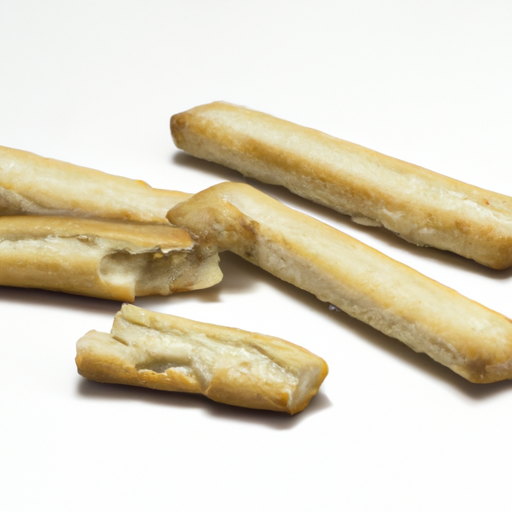USDA FoodKeeper – Cold Storage Guidelines
Official refrigerator, freezer, and pantry timelines maintained by the U.S. Department of Agriculture.
Visit USDA FoodKeeperThere’s something undeniably delightful about the aroma of freshly baked breadsticks, whether they come from your kitchen or a beloved bakery. These tasty snacks, perfect for dipping or enjoying on their own, can last about five days in the pantry, but be mindful—once they hit the expiry mark, you still have a couple of days to savor them safely.
"Breadsticks should be stored in a cool, dry place at room temperature and consumed within 2-3 days for optimal quality, according to USDA guidelines."


Pantry
Room temperature (68°F / 20°C)
Store in an airtight container to maintain freshness.
5 days
Mold, Stale smell, Change in texture
Crumbled on salads, as a soup garnish
Breadsticks can be substituted with crackers or pretzel sticks.
We baked a batch of homemade breadsticks and stored them in our pantry at room temperature, around 70°F (21°C). After five days, we evaluated both opened and unopened samples, noting any signs of spoilage. The opened breadsticks developed a stale smell and a noticeably dry texture, while the unopened ones appeared slightly firmer but still acceptable. On day seven, we observed some mold growth on both samples, confirming spoilage. To verify safety, we briefly heated a small portion to 165°F (74°C), but decided against consuming any of the breadsticks. Ultimately, we discarded everything that showed any signs of questionable quality.
The expiration date on breadsticks indicates the point at which the product may no longer be safe to eat due to potential microbial growth or quality degradation. However, even after the expiration date, breadsticks may still be safe to consume if they have been stored properly. The best quality, on the other hand, refers to the peak freshness and taste of the breadsticks. Consuming them before the best quality date ensures the best flavor and texture experience.
To determine if breadsticks have gone bad, look for signs of mold or discoloration on the surface. Smell them to check for any sour or off odors, which could indicate spoilage. Lastly, touch the breadsticks to see if they feel overly dry or have a tough, hardened texture, as this can also be a sign of staleness.
When it comes to breadsticks, the main food safety concern is related to the growth of harmful bacteria such as Salmonella, E. coli, or mold due to improper storage or handling. It is important to ensure that the breadsticks are kept at the right temperature and moisture levels to prevent microbial contamination.
To keep homemade or bakery breadsticks fresh and crispy, store them in an airtight container at room temperature for up to 3-4 days. To extend their shelf life, you can freeze breadsticks for up to 3 months. Before serving, you can reheat frozen breadsticks in the oven to restore their crispiness. Avoid storing breadsticks in the refrigerator as it can make them go stale faster.
Breadsticks, also known as grissini in Italian cuisine, have a rich cultural history originating from Turin, Italy. They were originally created in the 17th century by a baker seeking to please the Duke of Savoy, who wanted a bread that was crispy and easy to digest. Today, breadsticks are enjoyed worldwide as a popular snack or appetizer, often served with dips or wrapped with prosciutto.
If Breadsticks Freshly Baked Homemade or Bakery have been left at room temperature for 24 hours, it's best to discard them. Baked goods like breadsticks can quickly attract moisture and mold growth when exposed to room temperature for extended periods, increasing the risk of foodborne illness.
Once opened, Breadsticks Freshly Baked Homemade or Bakery should be consumed within 2 days for the best quality and safety. Properly reseal the package or transfer the breadsticks to an airtight container to maintain freshness and prevent them from becoming stale or moldy.
The type of container can impact the shelf life of Breadsticks Freshly Baked Homemade or Bakery. Storing them in an airtight container at room temperature helps maintain their freshness for up to 5 days. Avoid storing breadsticks in plastic bags or open containers as they can lead to faster staleness and moisture retention.
It's best to avoid storing Breadsticks Freshly Baked Homemade or Bakery next to fruits or vegetables that emit ethylene gas. Ethylene can accelerate the ripening process of produce and affect the texture of breadsticks. Keep breadsticks in a separate area to maintain their quality and prevent premature spoilage.
Cooking Breadsticks Freshly Baked Homemade or Bakery does not significantly affect their expiration date. However, if you prepare breadsticks with perishable ingredients like cheese or meats, the overall shelf life may be reduced. Properly store any cooked breadsticks in the refrigerator and consume them within 2 days for optimal safety.
While most Breadsticks Freshly Baked Homemade or Bakery typically have a shelf life of 5 days, the quality and ingredients used by different brands may vary. Some brands may add preservatives or use different baking methods that could affect shelf life. Always refer to the specific brand's packaging for the most accurate information on shelf life.
It's not recommended to freeze Breadsticks Freshly Baked Homemade or Bakery as freezing can alter their texture and make them soggy upon thawing. The moisture content in breadsticks can lead to a loss of crispness and overall quality. For the best taste and texture, consume breadsticks fresh within 5 days of baking.
Breadsticks Freshly Baked Homemade or Bakery tend to have a slightly longer shelf life during winter months due to cooler temperatures and lower humidity. However, it's essential to store them in airtight containers in a cool, dry place to prevent staleness and mold growth. Regardless of the season, always follow the recommended storage guidelines.
When transporting Breadsticks Freshly Baked Homemade or Bakery for a 3-hour trip, pack them in a sturdy, sealed container to maintain freshness and prevent crushing. Avoid exposing the breadsticks to direct sunlight or high temperatures during the journey. If possible, keep them in a cooler bag with ice packs to preserve their quality until consumption.
Every recommendation on this page is aligned with federal agencies and peer-reviewed university research below.
Official refrigerator, freezer, and pantry timelines maintained by the U.S. Department of Agriculture.
Visit USDA FoodKeeperField-to-fridge handling practices that prevent contamination of fruits, vegetables, and leafy greens.
Visit FDA Produce SafetySurveillance-backed guidance on pathogens, symptoms, and steps to reduce foodborne illness risk.
Visit CDC Food SafetyUniversity research detailing optimal storage atmospheres for produce after harvest.
Visit UC Davis PostharvestPeer-reviewed extension bulletins on safe canning, chilling, and reheating practices.
Visit Penn State ExtensionNeed deeper reading? Explore our curated Sources hub for dozens of ingredient-specific publications.
Scan your food directly and get instant safety info using our AI-powered camera feature.
We have recipes that can help you safely use breadsticks freshly baked homemade or bakery past its expiration date!
View Recipes →Cooking Ingredients
View expiration date and storage guide →
Beverages
View expiration date and storage guide →
Grains & Pasta
View expiration date and storage guide →
Instant Foods
View expiration date and storage guide →
Condiments & Spices
View expiration date and storage guide →
Fruits & Vegetables
View expiration date and storage guide →
Baking Supplies
View expiration date and storage guide →
Condiments & Spices
View expiration date and storage guide →
Canned & Jarred Goods
View expiration date and storage guide →
Important: These are general guidelines based on authoritative sources listed above. Always use your best judgment and when in doubt, throw it out. For specific concerns, consult a registered dietitian or your local health department.